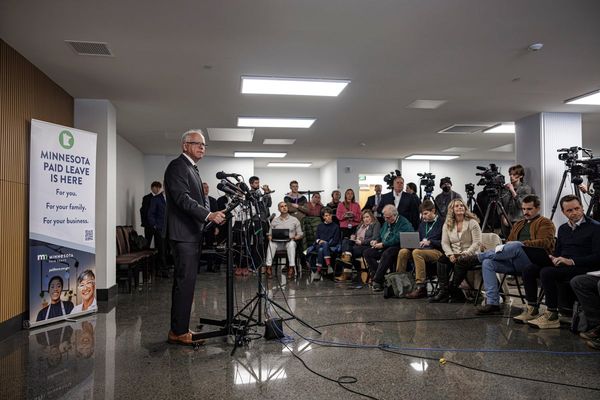SPOILER ALERT: this article contains plot references to Thor: Love and Thunder.
Chris Hemsworth’s Thor often refers to himself as the “strongest Avenger” – an idealistic manifestation of masculinity beyond the reach of ordinary mortal men.
Sure, this is mostly played for laughs, but if we look beyond the comedy, there is an interesting message about what it means to be a man underpinning the Thor franchise. It’s a message that has shifted and changed over the last decade, and not always for the better.
In the latest instalment, Thor: Love and Thunder , there is not one Thor but two: step forward the Mighty Thor, in the guise of the original’s one-time love, Jane Foster, played by Natalie Portman.
The Marvel Cinematic Universe (MCU) is a multi-billion-dollar multiverse franchise that unites a range of superheroes adapted from Marvel Comics. Hemsworth’s “space Viking” first appeared in the MCU in Kenneth Branagh’s 2011 movie Thor.
Even though this incarnation of Thor is a pastiche of masculine superheroes, the cues of stereotypical “normal” hypermasculinity were still at the core of the film. Yes, the audience were encouraged to laugh at Thor’s arrogance and roll their eyes at his insufferable hubris. But, in the end, it was his superior strength and aggression, combined with the love of a “good woman” – Jane Foster – that won the day in a celebration of hypermasculine prowess.
Playing with masculinity
It was all standard Hollywood action hero fare, and this continued into the second instalment in the franchise, Alan Taylor’s Thor: The Dark World (2013), as well as Joss Whedon’s cross-franchise The Avengers (2012) and Avengers: Age of Ultron (2015).
It wasn’t until New Zealand actor/director Taika Waititi took the helm for the third instalment, Thor: Ragnarok (2017), that we began to see a real shift in the representation of Thor’s masculinity. Here, it is celebrated for its ridiculousness not its effectiveness, planting the seeds for a new interpretation of how the hypermasculine can be understood in everyday culture.
In the Russo brothers’ Avengers: Endgame (2019), the reimagining of Thor’s masculinity took a potentially problematic turn. Having failed to prevent Josh Brolin’s Thanos – the ultimate bad guy in the MCU – from erasing half of life in the universe in Avengers: Infinity War (2018), Thor slips into depression.
In his depressive state, he is stripped of his masculine prowess. Now inhabiting a fat body that is exposed for comedic effect, Thor’s depression is correlated with laziness, a lack of personal hygiene and emotional instability.
In this new guise, he is diminished as a member of the Avengers, with his role as peak masculinity now taken by Mark Ruffalo’s Hulk character who has become Professor Hulk – a combination of the brute strength of the Hulk and superior intellect of Bruce Banner. “Fat” Thor is a jokey figure – the inverse of hypermasculinity.
The new ideal (spoiler alert!)
Things are different in Taika Waititi’s latest Thor: Love and Thunder (2022). In the opening montage of the movie, Thor returns his body to the hypermasculine form. Again it is ridiculous – as ridiculous as the gigantic screaming goats that carry his space boat across the universe.
He is still an exaggerated uber-muscled masculine presence, simultaneously a figure of ridicule and spectacle. He is to be consumed or scoffed at depending on your preference. Or maybe even both.
Jane Foster’s reimagining as the Mighty Thor introduces a new gender dynamic into the franchise. The Mighty Thor is just as powerful as Thor, or maybe even more so, as she comes to his rescue on several occasions. Yet Thor’s masculinity does not collapse or enter crisis in the face of powerful femininity.
In the end he works with the Mighty Thor as an equal to save the day. The arrival of this female Thor incarnation in the story amplifies the absurdity of Thor’s masculine hubris, but it does so in a way that still allows the audience to enjoy Thor’s laughable excesses.
Even though the central relationship explored in the movie is heterosexual, Thor’s masculinity is not rigidly heterosexual, as demonstrated in an amusing scene where he gazes into the eyes of Chris Pratt’s Star Lord, when asked about people he loves.
In Love and Thunder, Thor’s hypermasculinity is complex: arrogant and hubristic, but also caring. His supernatural strength causes and solves problems. It is is framed as aspirational and childlike, such as when, near the end of the movie, he shares his powers (temporarily) with the children he has set out to rescue. He is both a saviour and in need of saving.
Waititi’s Thors live in a reciprocal dynamic. We discover in flashback that it was Hemsworth’s Thor, in asking his hammer Mjölnir to protect Jane, who inadvertently caused her to become the Mighty Thor. Later, when it is revealed that Jane’s continued use of Mjölnir will lead to her death, she chooses to sacrifice herself to save Thor.
Ultimately, when Thor agrees to care for the orphaned daughter of the vanquished God Butcher played by Christian Bale, he becomes a new and idealised version of masculinity – one that is not only focused on the body, strength and physical superiority, but also on caring, nurturing and domestic life.
The new hypermasculine ideal realised by Hemsworth in Thor: Love and Thunder is fluid, contradictory and subject to change and interpretation, which seems a perfect fit for our changing times.
John Quinn does not work for, consult, own shares in or receive funding from any company or organization that would benefit from this article, and has disclosed no relevant affiliations beyond their academic appointment.
This article was originally published on The Conversation. Read the original article.







